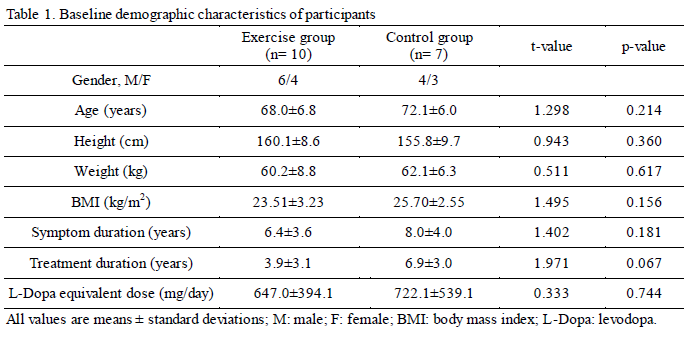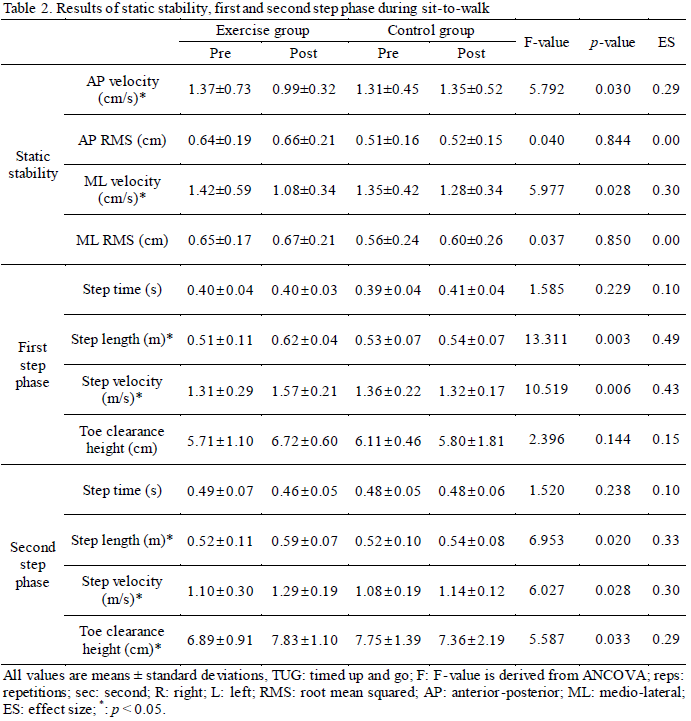Session Information
Date: Saturday, October 6, 2018
Session Title: Parkinson’s Disease: Clinical Trials, Pharmacology And Treatment
Session Time: 1:45pm-3:15pm
Location: Hall 3FG
Objective: The purpose of this study was to analyze the effects of progressive resistance and flexibility exercise of the trunk on static and dynamic stability for patients with Parkinson’s disease.
Background: Patients with Parkinson’s disease tend to suffer from axial structure impairment, such as axial rigidity and trunk deformity [1-3]. These symptoms do not only restrict daily activities, but also increase the risk of falling. Although axial structure impairment has low sensitivity, or less response to medications, there are few studies on the effects of intervention for axial structure impairment PD patients [4,5]. Therefore, it is necessary to analyze the static and dynamic stability analysis according to performed trunk exercise program.
Methods: All participants were participated the exercise group with 10 patients and the control group with 7 patients (Table 1). The program of progressive resistance and flexibility exercise for the trunk was conducted three times a week for 12 weeks. The static stability was evaluated by analyzing the trajectory of the center of pressure (COP) in an upright stance with the eyes open. The dynamic stability was evaluated by kinematic and kinetic variables during Sit-to-walk task at maximum speed. All statistical analyses were performed using SPSS (version 21.0, SPSS Inc). Analysis of covariance (ANCOVA) was performed with covariance data for preliminary measurements of clinical characteristics, static and dynamic stability to compare exercise intervention effects between the two groups. Significance was set at p < 0.05.
Results: In the static stability, the AP velocity(p=0.030) and the ML velocity(p=0.028) of the COP were significantly decreased after exercise in the group with the open eyes. In the first step phase, the step length(p=0.003), and the step velocity(p=0.006) at the lower extremity of first step were significant. In the second step phase, the step length(p=0.020), the step velocity(p=0.028), and the toe clearance height (p=0.033) of the second step were significant(Table 2).
Conclusions: The program of progressive resistance and flexibility exercises for the trunk had a positive influence on the improvement of functional fitness, trunk mobility, static and dynamic stability of patients with Parkinson’s disease. Further studies are needed to analyze the effects of a long-term program of progressive resistance and flexibility exercises for the trunk on the improvement of daily activities and on the prevention of falls in patients with Parkinson’s disease.
References: [1] Bridgewater, K. J., & Sharpe, M. H. (1998). Trunk muscle performance in early Parkinson’s disease. Physical Therapy, 78(6), 566-576. [2] Jankovic, J. (2008). Parkinson’s disease: clinical features and diagnosis. Journal of Neurology, Neurosurgery & Psychiatry, 79(4), 368-376. [3] Rodriguez-Oroz, M. C., Jahanshahi, M., Krack, P., Litvan, I., Macias, R., Bezard, E., & Obeso, J. A. (2009). Initial clinical manifestations of Parkinson’s disease: features and pathophysiological mechanisms. The Lancet Neurology, 8(12), 1128-1139. [4] Sethi, K. (2008). Levodopa unresponsive symptoms in Parkinson disease. Movement Disorders, 23(S3), S521-S533. [5] Steiger, M. J., Thompson, P. D., & Marsden, C. D. (1996). Disordered axial movement in Parkinson’s disease. Journal of Neurology, Neurosurgery & Psychiatry, 61(6), 645-648.
To cite this abstract in AMA style:
M. Lee, C. Youm, M. Son, H. Park, Y. Kim. Effects of progressive resistance and flexibility exercise program of trunk on static and dynamic stability for Parkinson’s disease [abstract]. Mov Disord. 2018; 33 (suppl 2). https://www.mdsabstracts.org/abstract/effects-of-progressive-resistance-and-flexibility-exercise-program-of-trunk-on-static-and-dynamic-stability-for-parkinsons-disease/. Accessed December 29, 2025.« Back to 2018 International Congress
MDS Abstracts - https://www.mdsabstracts.org/abstract/effects-of-progressive-resistance-and-flexibility-exercise-program-of-trunk-on-static-and-dynamic-stability-for-parkinsons-disease/


